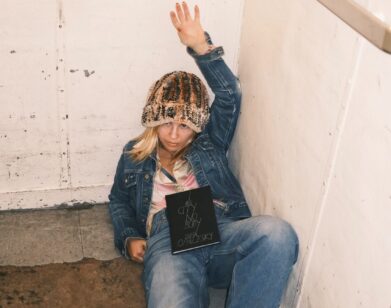Literary Ecstasy
“Take one look at a photograph of Patricia Highsmith at her Olympia SM3, and tell me she isn’t the fiercest typist you’ll ever see,” says Tim Youd by email to Interview. Beginning today and running through August 18, the Los Angeles-based artist will be behind the same kind of typewriter Highsmith used—an Olympia SM3—retyping every word of her novel The Talented Mr. Ripley as part of his performance art piece, Ecstatic Reading.
Held at Cristin Tierney Gallery, the performance is the latest installment of a decade-long project, 100 Novels, in which Youd retypes works at locations germane to each title. The idea first came to him as an epiphany. “I was reading a book in my studio and had this moment where I understood that, on a formal level, what I’d been looking at all those years was a rectangle of black text inside the larger white rectangle of the page,” Youd recalls. “I had this urge to compress the book—a physical, palpable urge—so that all the words in the entire novel would be present on that one page.”
Youd uses the same make and model typewriter as the original author, and in the past five years has completed a number of novels, from Virginia Woolf’s To The Lighthouse in Cornwall, England and William Faulkner’s The Sound and the Fury at Faulkner’s home in Oxford, Mississippi to Charles Bukowski’s Post Office in the back of a truck in front of Los Angeles’s Post Office Terminal Annex. The performances span days and sometimes weeks. As Youd explains, “A 300-page novel, given my two-finger technique, is a 70- or 80-hour typing project.” Each novel is retyped on a single sheet of paper fed repeatedly through the typewriter so that every word seeps into one another, resulting in an illegible black rectangle. The paper is backed by a second sheet that’s embossed by each keystroke. The two final pages are then framed as a diptych, one bearing a rectangle of ink, the other marks and impressions. The performance ends with the novel complete and, in a way, in tact—indecipherable, yet present in its entirety.
For Youd, this process is equal parts physical and spiritual. “It’s not an uncommon feeling for me to think that the immediate novel I am retyping has got to be the best novel I’ve ever read,” says Youd. “That of course can’t be true, but I love the feeling nonetheless because I’ve come to understand those moments in religious terms.” The feeling of understanding a text so profoundly that the connection transcends a purely intellectual one can, however, oftentimes be fleeting and Youd says, “I can sometimes step away and evaluate the particular novel in relation to others and conclude I had a tenuous basis for the momentary ecstasy. But the religious transport I felt is no less real for it.”
For his New York debut, Youd will delve into the mind of Highsmith’s Tom Ripley. “It’s a novel about pain—deep, personal, existential pain—and the extent a person will go to to attempt to relieve that pain,” says Youd. “It’s really a searing life-view, told with caustic wit and humor. It’s a novel I’ve looked forward to retyping since I started my project.”
Youd’s performances may bring to mind Hunter S. Thompson, who retyped titles by Ernest Hemingway and F. Scott Fitzgerald, likely hoping to osmose their literary finesse. Youd, on the other hand, devotes his literary pilgrimage to becoming a better reader. “I’ve come to understand that it’s about the attempt to be the best reader I can be,” he says. The performance is, after all, titled Ecstatic Reading.
ECSTATIC READING IS ON VIEW AT CRISTIN TIERNEY GALLERY IN NEW YORK THROUGH AUGUST 18, 2017. FOR MORE ON TIM YOUD, VISIT HIS WEBSITE.







